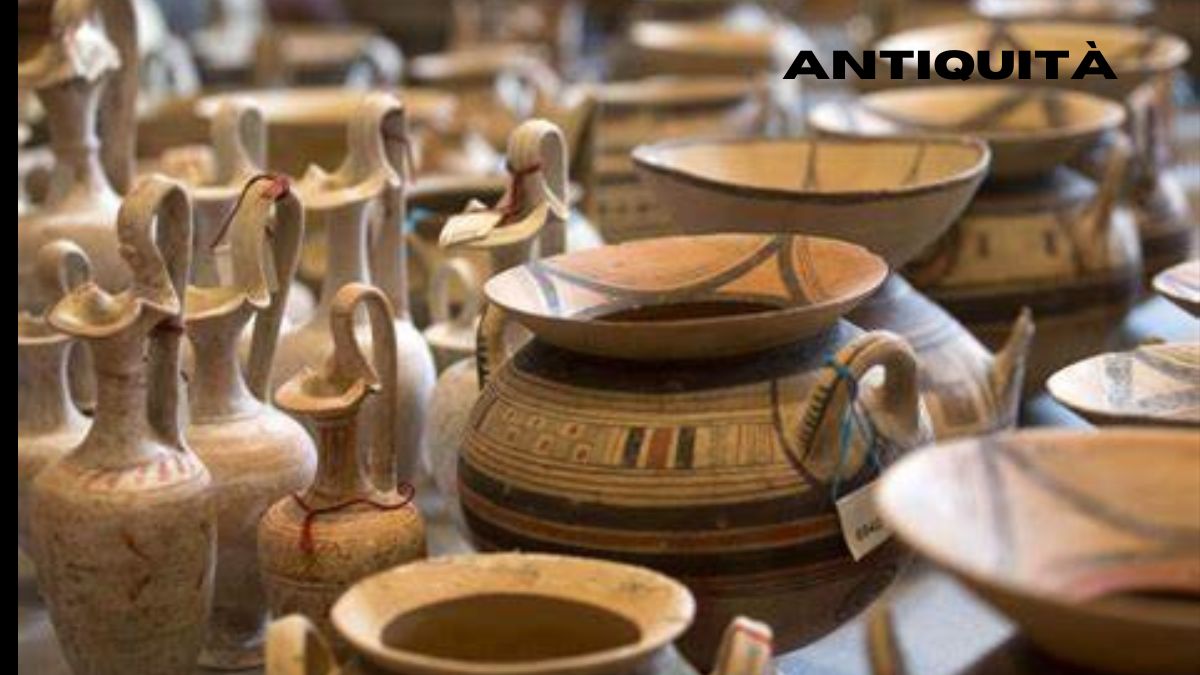General
Introduction To Antiquità

Antiquità, the Italian word for “antiquities,” refers to objects or artifacts from ancient civilizations that hold historical, cultural, or artistic significance. These treasures provide a window into the past, offering valuable insights into the lives, beliefs, and achievements of our ancestors. In this article, we delve into the world of antiquità, exploring its historical significance, modern-day relevance, preservation challenges, and the role of technology in safeguarding these invaluable relics.
The Historical Significance of Antiquità
Ancient Civilizations and Artifacts
Antiquità encompasses artifacts from various ancient civilizations, including the Egyptians, Greeks, Romans, and Mesopotamians. These artifacts range from pottery and sculptures to coins and architectural remnants, each telling a unique story of its time. They offer invaluable clues about ancient societies, their customs, beliefs, and technological advancements.
Preservation Efforts
Over the centuries, numerous efforts have been made to preserve antiquità for future generations. Archaeological excavations, conducted with meticulous care, aim to unearth these treasures while minimizing damage. Additionally, cultural heritage laws and international conventions seek to protect antiquities from theft, illegal trafficking, and destruction.
Exploring Antiquità in Modern Times
Museums and Exhibitions
Museums play a vital role in showcasing antiquità to the public. Through carefully curated exhibitions, these institutions educate visitors about ancient civilizations and their cultural legacy. From iconic artifacts like the Rosetta Stone to lesser-known relics, museums provide a platform for appreciation and study.
Cultural Impact
The study of antiquità not only enriches our understanding of history but also influences contemporary culture. Art, literature, and cinema often draw inspiration from ancient civilizations, reflecting on themes of mythology, power, and human nature. By studying antiquities, we gain insights into universal human experiences that transcend time and geography.
Challenges in Preserving Antiquità
Illegal Trafficking and Looting
One of the greatest threats to antiquità preservation is the illegal trade in cultural artifacts. Archaeological sites are frequently targeted by looters seeking to profit from the sale of stolen relics on the black market. This illicit trade not only robs nations of their heritage but also fuels organized crime and funds terrorist activities.
Environmental Factors
Environmental factors, such as climate change and pollution, pose significant challenges to antiquities preservation. Exposure to air pollution, fluctuating temperatures, and natural disasters can accelerate the deterioration of artifacts. Rising sea levels also threaten coastal archaeological sites, putting invaluable treasures at risk of being lost forever.
The Role of Technology in Antiquità Preservation
Digital Archives and Documentation
Advancements in technology have revolutionized the way we document and preserve antiquities. Digital imaging techniques, such as 3D scanning and photogrammetry, allow for the creation of detailed digital replicas of artifacts. These digital archives serve as valuable resources for researchers, educators, and conservationists.
Virtual Reality and Augmented Reality
Virtual reality (VR) and augmented reality (AR) technologies offer immersive experiences that bring antiquities to life. Through VR simulations, visitors can explore ancient ruins or interact with virtual reconstructions of historical sites. AR applications enhance museum exhibits by overlaying digital information onto physical artifacts, providing context and enhancing engagement.
Collaborative Efforts in Antiquità Preservation
International Organizations
Collaboration between nations and international organizations is essential for the preservation of antiquities. Initiatives such as UNESCO’s World Heritage program aim to safeguard cultural and natural treasures around the globe. By fostering cooperation and sharing resources, these organizations help protect antiquities for future generations.
Community Involvement
Local communities also play a crucial role in antiquities preservation. Engaging with stakeholders, including indigenous peoples and descendant communities, ensures that conservation efforts are culturally sensitive and sustainable. By empowering communities to take ownership of their heritage, we can foster a sense of pride and responsibility for safeguarding antiquities.
Conclusion
Antiquità are more than just ancient artifacts; they are windows into the past, connecting us to our shared human heritage. As custodians of these treasures, we have a responsibility to protect and preserve them for future generations. By leveraging technology, fostering collaboration, and engaging with communities, we can ensure that antiquities continue to inspire and educate for centuries to come.
General
Lawyers Guns and Money Blog: Legal Professionals in Digital Age

Legal professionals have long relied on traditional methods of communication and networking to establish their expertise and attract clients. However, in today’s digital age, the landscape is rapidly changing, and the internet has become a powerful tool for lawyers to connect with their audience and showcase their knowledge. One such avenue is through the creation of a legal blog, and “Lawyers Guns and Money” is at the forefront of this digital revolution.
Importance of Legal Blogs
Information Dissemination
In an era where information is readily accessible online, legal blogs serve as a valuable platform for sharing insights, analysis, and updates on various legal matters. Whether it’s discussing recent court rulings. Legislative changes, or offering practical advice, legal blogs provide a wealth of information to both legal professionals and the general public.
Building Credibility
Maintaining a well-written and informative blog can significantly enhance a lawyer’s credibility and authority in their field. By consistently delivering valuable content, lawyers can establish themselves as thought leaders and trusted advisors within their respective areas of expertise.
Client Education
Legal blogs also play a crucial role in educating clients about their rights, responsibilities, and the legal process. By demystifying complex legal concepts and providing practical guidance. Lawyers can empower their clients to make informed decisions and navigate legal challenges more effectively.
How to Start a Legal Blog
Choosing the Right Platform
Before diving into the world of legal blogging, it’s essential to select the right platform that aligns with your goals and preferences. Popular options include WordPress, Blogger, and Medium, each offering unique features and customization options to suit your needs.
Identifying Your Niche
To stand out in a crowded digital landscape, it’s important to identify a specific niche or focus area for your legal blog. Whether it’s family law, corporate litigation, or intellectual property, honing in on a particular niche allows you to tailor your content to a targeted audience and establish yourself as an authority in that area.
Creating Engaging Content
The success of any blog hinges on the quality and relevance of its content. When creating posts for your legal blog, aim to provide valuable insights, practical tips, and actionable advice that resonate with your audience. Incorporating multimedia elements such as infographics, videos, and case studies can also enhance engagement and readability.
Monetizing Your Legal Blog
Affiliate Marketing
One way to monetize your legal blog is through affiliate marketing, where you promote products or services related to your niche and earn a commission for referrals or sales generated through your blog. Partnering with reputable companies and selecting products that align with your audience’s interests can help maximize your earning potential.
Sponsored Content
Another revenue stream for legal bloggers is sponsored content. Where brands or organizations pay you to create and publish content that promotes their products or services. When pursuing sponsored opportunities, it’s essential to maintain transparency and ensure that any sponsored content aligns with your blog’s values and audience expectations.
Offering Legal Services
Beyond generating passive income, a legal blog can also serve as a marketing tool to attract potential clients and grow your legal practice. By showcasing your expertise and demonstrating your commitment to serving your audience. You can position yourself as the go-to legal resource in your niche and drive inquiries for your services.
Tips for Successful Legal Blogging
Consistency is Key
To build a loyal following and maintain momentum, consistency is paramount when it comes to blogging. Whether it’s posting weekly updates, monthly newsletters, or quarterly roundups, establishing a regular publishing schedule helps keep your audience engaged and reinforces your commitment to providing valuable content.
Engage with Your Audience
Effective blogging is a two-way street, and engaging with your audience is essential for fostering a sense of community and building trust. Encourage feedback, respond to comments and inquiries promptly, and consider hosting live Q&A sessions or webinars to interact directly with your audience and address their needs.
Stay Updated with Legal Trends
The legal landscape is constantly evolving, with new laws, regulations, and precedents shaping the industry. As a legal blogger, it’s crucial to stay abreast of these developments and adapt your content strategy accordingly. By staying informed and offering timely insights on emerging trends, you can position yourself as a trusted source for up-to-date legal information.
Conclusion
“Lawyers Guns and Money” is more than just a blog—it’s a dynamic platform for legal professionals to share knowledge, connect with their audience, and thrive in the digital age. By leveraging the power of blogging. Lawyers can elevate their online presence, expand their reach, and ultimately, drive success in their legal careers.
General
Introduction to Site Surveys

Site survey are integral processes conducted to gather essential information about a specific location. Whether it’s for construction, engineering, or environmental purposes, site surveys provide invaluable data that informs decision-making processes.
Importance of Site Survey
Site surveys play a crucial role in various industries, ensuring that projects are planned and executed efficiently. They provide detailed insights into the terrain, existing structures, and potential challenges that may arise during development.
Types of Site Surveys
Topographical Surveys
Topographical surveys focus on mapping the natural and man-made features of a site, including elevation changes, vegetation, and existing infrastructure.
Construction Surveys
Construction surveys are conducted to establish precise locations for proposed structures, ensuring alignment with design specifications and compliance with regulatory requirements.
Utility Surveys
Utility surveys involve identifying and mapping underground utilities such as water pipes, electrical lines, and telecommunications cables to prevent accidental damage during construction activities.
Steps Involved in Conducting a Site Survey
Preparing for the Survey
Before commencing the survey, thorough planning is essential. This involves reviewing project requirements, obtaining necessary permits, and scheduling survey activities.
Conducting the Survey
During the survey phase, surveyors utilize advanced equipment such as total stations, GPS receivers, and laser scanners to collect accurate data about the site.
Analyzing the Data
Once data collection is complete, surveyors analyze the gathered information to create detailed maps, reports, and digital models of the site.
Tools and Equipment Used in Site Surveys
Modern site surveys rely on a variety of advanced tools and equipment, including:
- Total Stations
- GPS Receivers
- Laser Scanners
- Drones
These technologies enable surveyors to collect precise measurements and capture comprehensive data.
Benefits of Utilizing Site Survey Data
The utilization of site survey data offers numerous benefits, including:
- Improved project planning and design
- Minimized risks and errors during construction
- Enhanced decision-making based on accurate information
- Cost savings through efficient resource allocation
Challenges and Limitations of Site Surveys
Despite their advantages, site surveys come with certain challenges and limitations, such as:
- Accessibility issues in remote or hazardous environments
- Weather conditions impacting data collection
- Accuracy limitations of surveying equipment
Case Studies: Real-World Applications of Site Surveys
Urban Development Project
In a large-scale urban development project, site surveys were instrumental in assessing land suitability, identifying potential hazards, and optimizing infrastructure placement.
Environmental Conservation Efforts
Site surveys have been crucial in environmental conservation efforts, helping to map ecosystems, monitor biodiversity, and plan sustainable land management strategies.
Future Trends in Site Survey Technologies
As technology continues to advance, the future of site surveys holds exciting possibilities, including the integration of artificial intelligence, automation, and augmented reality for enhanced data collection and analysis.
Conclusion
Site survey are invaluable tools that provide essential data for various industries, from construction and engineering to environmental conservation. By leveraging advanced technologies and methodologies, surveyors can ensure the efficient planning, execution, and management of projects.
General
Introduction to Panclasa

Panclasa is a multifaceted compound that has gained attention for its diverse applications in various fields. Its unique properties make it a valuable substance in both medical and industrial sectors. In this article, we will delve deeper into the origins, composition, uses, benefits, and potential risks associated with Panclasa.
History and Origin
The history of Panclasas dates back to the early 20th century when it was first synthesized by renowned chemists. Initially developed for industrial purposes, its medicinal properties were later discovered, leading to extensive research and exploration of its therapeutic benefits.
Composition of Panclasas
Panclasa is primarily composed of organic compounds, with a distinct molecular structure that confers its characteristic properties. Its composition may vary slightly depending on the manufacturing process and intended application.
Uses of Panclasa
Medical Applications
In the medical field, Panclasa has been utilized for its analgesic, anti-inflammatory, and antimicrobial properties. It is commonly prescribed for the treatment of various ailments, including but not limited to:
- Pain management
- Inflammation
- Infections
Industrial Applications
In industries, Panclasas serves as a key ingredient in the production of diverse products ranging from pharmaceuticals to cosmetics. Its versatility and efficacy make it an indispensable component in manufacturing processes.
Benefits of Panclasas
Panclasas offers numerous benefits, including:
- Effective pain relief
- Reduction of inflammation
- Antibacterial properties
- Versatile applications in different industries
Side Effects and Risks
While Panclasas is generally considered safe when used as directed, it may cause side effects in some individuals. Common side effects include:
- Gastrointestinal discomfort
- Allergic reactions
- Skin irritation
How to Use Panclasas Safely
To minimize the risk of adverse effects, it is essential to follow dosage instructions provided by healthcare professionals. Additionally, individuals with pre-existing medical conditions or allergies should consult their doctor before using Panclasas.
Availability and Pricing
Panclasas is available in various forms, including tablets, capsules, and topical creams. Its pricing may vary depending on the formulation and brand. It is commonly found in pharmacies and online retailers.
Comparison with Alternatives
When considering options for pain relief and inflammation management, Panclasas is often compared to other medications and natural remedies. While each option has its advantages and limitations, Panclasa stands out for its efficacy and widespread availability.
Consumer Reviews and Testimonials
Many individuals have reported positive experiences with Panclasas, citing its effectiveness in alleviating pain and improving overall well-being. Consumer reviews and testimonials provide valuable insights into the real-world impact of this compound.
Research and Studies on Panclasas
Numerous research studies have been conduct to explore the therapeutic potential of Panclasas. These studies have yielded promising results, further validating its use in medical and industrial settings.
Future Prospects
As research on Panclasas continues to evolve, it is likely that new applications and formulations will emerge, further expanding its utility and relevance in various fields.
Conclusion
Panclasas is a versatile compound with widespread applications in medicine and industry. Its unique properties make it a valuable asset for pain relief, inflammation management, and antimicrobial interventions. While it is essential to use Panclasa responsibly and under professional guidance, its benefits far outweigh the potential risks.
-

 Technology10 months ago
Technology10 months agoWhat is a Network Termination Unit (NTU)?
-

 General9 months ago
General9 months agoIntroduction to the Concept of a Favorite Daughter
-

 Travel10 months ago
Travel10 months agoExploring the Wonders of myfavouriteplaces.org:// blog
-

 Technology7 months ago
Technology7 months ago.vid Format: Maximizing Video Content Impact
-

 Celebrity10 months ago
Celebrity10 months agoMatthew Mcconaughey Net Worth
-

 Technology10 months ago
Technology10 months agoInstagram Stories No Sound: Unveiling the Silence Dilemma
-

 News8 months ago
News8 months agoNokia Lumia 1320 now available from Cricket Wireless for $229 after rebate
-

 Technology7 months ago
Technology7 months agoAmazon GPT-55X: Revolutionizing AI-Powered Solutions
